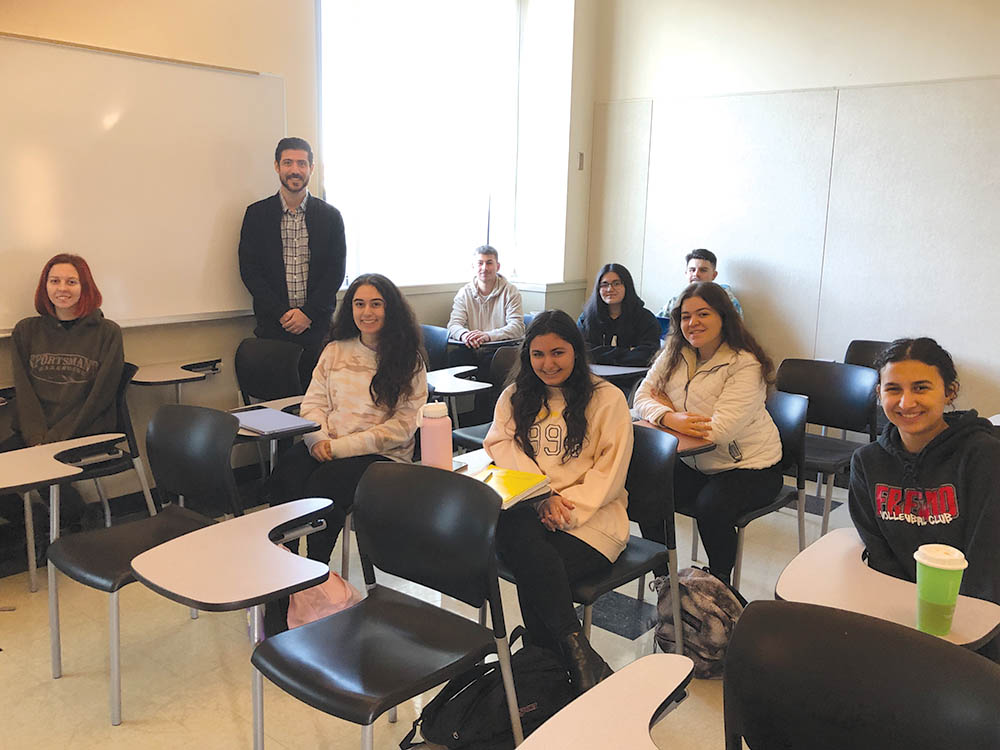
Photo: Barlow Der Mugrdechian
Natalie Agazarian
Staff Writer
Armenian Studies 10, Introduction to Armenian Studies, is a General Education course taught by Dr. Hagop Ohanessian. The class is designed “to serve as an introduction to the historical and contemporary experience of Armenians in American society. It fulfills Area D2 of the Fresno State General Education requirements and is a required course in the Armenian Studies Minor.
Armenian Studies 10 explores broad concepts such as identity, ethnicity, immigration, assimilation, cultural heritage, and genocide. Dr. Ohanessian said that the structure of the class “engages students in experiencing their own ethnic identity.” This is encouraged through an assigned paper that asks students to explore their family background.
“My favorite part of the course has been writing our family identity paper… I got to learn about my family’s roots and hardships living in the Middle East and eventually moving to the United States,” said Jamie Manock. Students can make connections based on their own first-hand experiences or the experiences of their ancestors. The emphasis on personal and cultural identity throughout the semester makes it applicable and inviting to all students.
The course also studies the history and current events of the Republic of Armenia and Artsakh (Nagorno-Karabakh), the concept of the Armenian diaspora, and the diversity within the Armenian community. The ongoing war between Armenia and Azerbaijan has greatly contributed to the relevance of this course and Dr. Ohanessian hopes that the course can spread more awareness about the Armenian people and “spark more interest in current affairs.”
Students conveyed the successful accomplishment of the goal to increase awareness and attention on current events, specifically in relation to the Armenian people.
“Growing up, I never fully understood what the Genocide was and how it impacted Armenians,” said Manock. “It is very important to educate students on Armenian studies because many students are completely unaware of what’s happened and is happening.” Michelle Gonzalez recalls that her favorite part of the course was “seeing photos of Armenia for the first time” and how it educated her on the importance of going “beyond your own culture to see what other people have gone through.”
Along with the historical and individual experiences, the course also delves into the experience of Armenians in American society, specifically in the Central Valley and more specifically, Fresno.
“Learning about Fresno and how the Armenian community has been built up from different areas and different cultures and still maintains the Armenian aspect shows the endurance of the Armenian people,” said Christopher Petrosian.
One of Dr. Ohanessian’s goals for the course is to highlight the “contributions Armenians have made to this community” and to develop a “rich appreciation of the history of Armenians in Fresno.” Students learned that the Fresno Armenian community dates back as far as 1881 and played an integral role in the development of Fresno. This was despite the prejudice and discrimination they faced amid the challenges of assimilation. Armenians were known for farming, various forms of skilled labor, and the emergence of Armenian-American writers, such as William Saroyan, which connected the Armenian and American experience through literature.
“I really enjoy the readings we do, especially the readings of Armenian-American writers and how it relates to the diaspora, as well as the Genocide,” stated Careen Derkalousdian.
Through an examination of history, expression of identity, and exploration of the Armenian-American experience, the Introduction to Armenian Studies course is one that not only satisfies necessary course requirements, but also sheds light into the contemporary history of the Armenian people.
 Hye Sharzhoom Armenian Action
Hye Sharzhoom Armenian Action